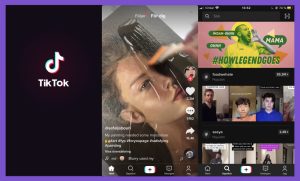Why TikTok’s “Core-Core” movement encapsulates teenage digital behavior
Millions of colored pixels on your screen stream into your algorithm as you scroll through TikTok. In the blink of an eye, you come across a short video filled with a compilation of micro-clips. Compiled cuts of massive influencer “fast fashion hauls” go straight to shots of polar bears in the Arctic balancing on small ice sheets from global warming – all with a somber instrumental sound in the background. Within a split second, you have entered the world of CoreCore, to me, the internet’s most absurdist art movement.
For me, the CoreCore movement is an ode to the philosophy of absurdism, which is established in the paradoxical situation between our impulse to ask ultimate questions about the human experience, and the uncertainty of achieving a direct answer. While every CoreCore video remains subjective to each viewer, all CoreCore videos shed light upon deeper topics regarding humanity. The very paradox that we cannot resolve the ultimate questions presented in a CoreCore, is what leaves such a significant impact on the digital behaviors of teenage viewers, like me.
Not only this, the overall existence of this internet movement highlights something more profound about our digital activity on social media. The CoreCore movement parallels the digital behaviors online which divide my real, and online life. As I scroll through yet another CoreCore video on my ‘For you page’ (FYP), I realize how dynamic the differences are between my behaviors online, and in reality.

CoreCore even brings many teenage viewers, like me, out of “the loop” when scrolling past perpetual algorithms.
“Every time I watch a CoreCore video, it brings me out of the loop of continuously scrolling through my FYP. CoreCore makes me think more deeply about the world around me,” Karaline Duke, a 17-year-old TikTok user, told me in an interview.
For teenagers like myself who are part of a generation born into technology, CoreCore juxtaposes the disconnectedness of the internet with the intensity of real life. Watching a CoreCore video takes me to a whole realm of different perspectives and reflects the disconnectedness I sometimes feel as I navigate two completely different worlds – my in-person reality, and my seemingly perpetual digital reality.
In fact, a finding by the Pew Research Center reinforces this “seemingly perpetual” teenage reality of social media. According to the finding, nearly half of US teens say they use social media “almost constantly.” In my own life, gliding my finger on my phone screen, absorbing excessive amounts of information from social media algorithms has become a rhythm of digital movement. Like other teenagers my age, I frequently find myself briskly navigating my FYP, addicted to the next hit of dopamine with every video.

CoreCore videos act as digital mediums where the reality of contemporary society and emotions are expressed in the same rapidly induced manner, mirroring how teenage users already consume content.
Ironically, like the rough cuts from clip-to-clip in a CoreCore video, my experience navigating the internet mimics the CoreCore movement, reflecting on the digital culture of teenagers in my generation, developed through the hyper-consumption of social media.
It should be noted that this irony shouldn’t necessarily be a bad thing. Most teenagers’ FYPs often portray idealized versions of reality that stray far away from the real world. The juxtaposition of CoreCore allows teenagers to reflect on our digital behaviors and the vibrancy of the real world.
In many CoreCore videos, cuts of various kinds of media from movies, memes, interview clips, and more are combined to invoke a sense of emotion while viewing the video. As I scroll through the CoreCore content that pops up on my own screen, its existential and melancholic themes became clear.
For example, one CoreCore video on TikTok includes compilations of bright Times Square billboard advertisements, WALL-E scenes, global warming news segments, and Mark Zuckerberg speeches. This CoreCore notions anti-capitalist concepts, commenting on the repercussions of our hyper-consumerist behaviors on the world. Other videos comment on facing misogyny and the female experience in modern society, how women have unrealistic expectations to live up to, the dangers of being a female, and more.

Regardless of how different each CoreCore video is, each fundamentally includes one thing- a meaning that can be understood beyond the walls of language. This meaning encapsulates the absurd manner of teenage digital culture. One in which we navigate the intersections between true reality and seemingly “constant” teenage usage of social media.
All in all, through a compilation of a series of internet moments, “CoreCore ” creators evoke emotions through media that can’t be represented through words. Through introspective visuals, these videos not only comment on the oversaturated nature of being a human being in the 21st century but also emulate the digital behaviors of a generation entranced by a blue screen light.
CoreCore videos should continue streaming into our FYPs and surging the digital pockets of absurdism we never really knew we needed. CoreCore is a profound digital intersection between our online, and real lives. It is a media movement that has impacted me in a way I don’t think any flow of content ever has. As I continue my passage into adulthood, I hope that the ultimate questions and social commentaries CoreCore presents to teenagers like me continue to mirror our absurd digital behaviors.






